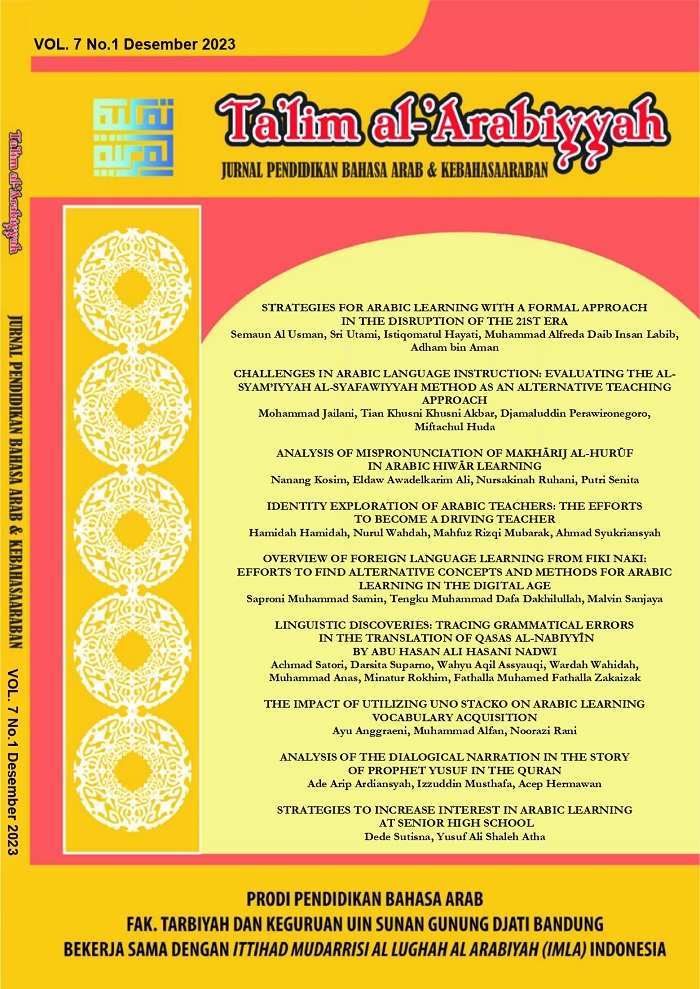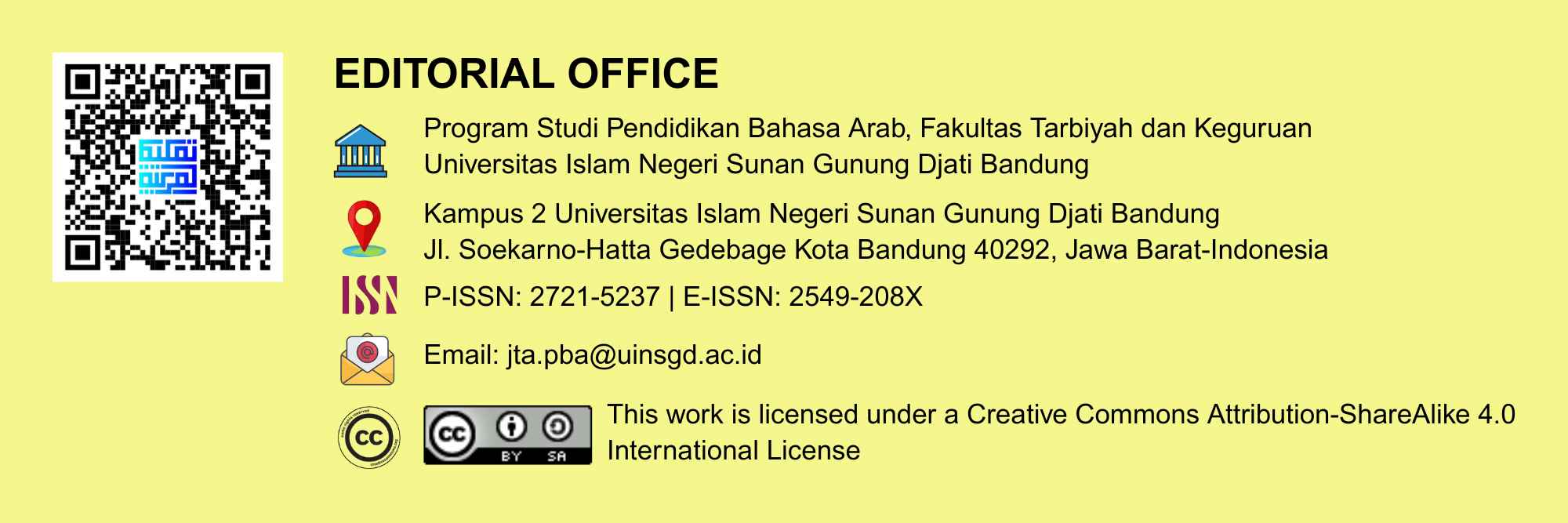Strategies for Arabic Learning with a Formal Approach in the Disruption of the 21st Era
DOI:
https://doi.org/10.15575/jpba.v7i2.22667Keywords:
Arabic Learning, Disruption Era, Formal Approach, Learning StrategiesAbstract
In essence, learning to master the language has significant achievements, as well as Arabic language learning. Ideally, Arabic language learning allows learners to master the four language skills (al-istimÄ', al-kalÄm, al-qirÄ'ah, and al-kitÄbah) functionally and proportionally. This approach considers language learning as a routine activity that is conventional and considered classical, following the usual ways of doing it based on experience. This study uses descriptive qualitative and several data sources by looking for literature references and documentation through manuscripts that follow the research. This research aims to discover that the era has entered the aspects of learning and teaching methods as a characteristic of the era of globalization. Science and technology are developing quickly and becoming increasingly sophisticated, with an increasingly broad role. 21st-century learning is a transition of learning where the curriculum developed leads schools to change the learning approach from teacher-centered to student-centered. It is following future demands where students must be able to think and learn by the demands of the times. These skills include problem-solving, critical thinking, collaboration, and communication skills so that the output from the old (traditional) strategy can still be used by prioritizing abilities centered on students. This study recommends future research to explore optimal ways of integrating artificial intelligence in Arabic language learning. Thus, this research contributes to the understanding and strategic application of advancing Arabic language learning in the Disruption 21 era.
References
Al-Harbi, M., Obeidat, R., Al-Ayyoub, M., & Alawneh, L. (2023). Question-Aware Deep Learning Model for Arabic Machine Reading Comprehension. In A. Bennour, A. Bouridane, & L. Chaari (Eds.), Intelligent Systems and Pattern Recognition (Vol. 1941, pp. 262–276). Springer. https://doi.org/10.1007/978-3-031-46338-9_20
Amila Sholiha, R Umi Baroroh, & Razita Binti Abdullah. (2023). Innovation in Reading Skills Assessment in Arabic Textbooks Based on HOTS Assessment. Izdihar : Journal of Arabic Language Teaching, Linguistics, and Literature, 6(2), 231–242. https://doi.org/10.22219/jiz.v6i2.27151
Anaktototy, K. (2023). Promoting Creativity and Innovation in The Teaching and Learning Process. Edu Sciences Journal, 4(1), 59–66. https://doi.org/10.30598/edusciencesvol4iss1pp59-66
Andayani, W. (2015). Berbagai Alternatif Pengembangan Metodologi Pembelajaran Bahasa di SMP Negeri 1 Kampak Trenggalek. Karya Ilmiah Dosen, 1(1), 36–49. Retrieved from https://journal.stkippgritrenggalek.ac.id/index.php/kid/article/view/12
Ardiansyah, A. A., & Aziz, A. A. (2019). TaisÄ«r An-Naḥwi al Ta’lÄ«mÄ« lÄ« GarḠQirÄati An-Nuṣūṣ Al-‘Arabiyyah Gair al-MasykÅ«lah. LISANUDHAD, 6(2), 86–110. https://doi.org/10.21111/lisanudhad.v6i2.3478
Ardiansyah, A. A., & Muhammad, A. (2020). Implementation of Integrative Arabic Grammar (Nahwu & Sharaf) Curriculum in Islamic Boarding School. Izdihar : Journal of Arabic Language Teaching, Linguistics, and Literature, 3(3), 211–228. https://doi.org/10.22219/jiz.v3i3.13264
Arifianto, M. L., Ainin, M., Ahsanuddin, M., Irhamni, I., Fitria, N., Nikmah, K., & Anwar, M. S. (2021). Evaluasi Pembelajaran dan Pengembangan Tes Interaktif Bahasa Arab. Tonggak Media.
Awaluddin, A. F. (2021). Kemampuan Baca Kitab Kuning di Pesantren (Studi Komparatif Metode Mumtaz dan Metode Qawaid wa Tarjamah pada Pendidikan Diniyah Formal (PDF). Pusaka, 9(2), 199–208. https://doi.org/10.31969/pusaka.v9i2.524
Bustam, B. M. R., Iswanto, I., Arqam, Mhd. L., Juliani, W. I., & Khairi, A. N. (2021). The Effectiveness of Fun Learning Approach in Arabic Learning. Jurnal Al Bayan: Jurnal Jurusan Pendidikan Bahasa Arab, 13(2), 286–304. https://doi.org/10.24042/albayan.v13i2.8681
Caldana, A. C. F., Eustachio, J. H. P. P., Lespinasse Sampaio, B., Gianotto, M. L., Talarico, A. C., & Batalhão, A. C. D. S. (2023). A Hybrid Approach to Sustainable Development Competencies: The Role of Formal, Informal and Non-Formal Learning Experiences. International Journal of Sustainability in Higher Education, 24(2), 235–258. https://doi.org/10.1108/IJSHE-10-2020-0420
Efrati, Y. (2023). Parent-Child Quality of Sex-Related Communication Before and During the COVID-19 Pandemic. Children and Youth Services Review, 153(1), 107105. https://doi.org/10.1016/j.childyouth.2023.107105
Fernando, S. Y., & Marikar, F. M. (2017). Constructivist Teaching/Learning Theory and Participatory Teaching Methods. Journal of Curriculum and Teaching, 6(1), 110–122. https://doi.org/10.5430/jct.v6n1p110
Ghani, S. Ab., Ahmad, S. Z. @ Hj., Hashim, U. H. Hj., Shaadon, Z., & Mustapa, N. S. (2012). Application of basic Skills in Reading Arabic Text for Teaching and Learning Maharat Al-Qiraah. Procedia - Social and Behavioral Sciences, 59(1), 26–32. https://doi.org/10.1016/j.sbspro.2012.09.241
Hanani, N. (2020). Pembelajaran Bahasa Arab Kontemporer: Konstruksi Metodologis Pembelajaran Bahasa Arab Berbasis Komunikatif-Sosiolinguistik. CV Cendekia Press.
Hermawan, A. (2018). Metodologi Pembelajaran Bahasa Arab (Edisi Revisi). Remaja Rosdakarya.
Hidayat, A., & Rahmah, S. N. (2020). Relevansi Thariqah Qawaid-Tarjamah pada Perguruan Tinggi. Tatsqifiy: Jurnal Pendidikan Bahasa Arab, 1(1), 47–55. https://doi.org/10.30997/tjpba.v1i1.2575
Jamil, H., & Sardiyanah, S. (2020). Eksistensi Metode Qawaid Tarjamah dalam Pembelajaran Bahasa Arab di Era Revolusi 4.0. Jurnal Naskhi: Jurnal Kajian Pendidikan Dan Bahasa Arab, 2(1), 30–39. https://doi.org/10.47435/naskhi.v2i1.289
Krissandi, A. D. S., Widharyanto, B., & Dewi, R. P. (2018). Pembelajaran Bahasa Indonesia untuk SD (Pendekayan dan Teknik). Media Maxima.
Kusnadi, K. (2019). Metode Gramatika Dalam Pembelajaran Bahasa Arab. Jurnal Naskhi: Jurnal Kajian Pendidikan Dan Bahasa Arab, 1(1), 8–13. https://doi.org/10.47435/naskhi.v1i1.66
Maskur, A., & Anto, P. (2018). Metode Pembelajaran Bahasa Asing Arab di Pondok Pesantren Modern. El-Banar: Jurnal Pendidikan Dan Pengajaran, 1(1), 63–68. https://doi.org/10.54125/elbanar.v1i1.10
Mela, D. A., Hasanah, M., & Ramadhan, M. F. (2023). Reading Guide and Students’ Arabic Reading Ability. Kitaba, 1(2), 48–59. https://doi.org/10.18860/kitaba.v1i2.21277
Mira, M., Syihabudin, S., & Nurbayan, Y. (2020). Evaluation Of Arabic Learning Using The Kahoot Application In The Pandemic Era Of Covid-19. Ta’lim al-’Arabiyyah: Jurnal Pendidikan Bahasa Arab & Kebahasaaraban, 4(2), 153–164. https://doi.org/10.15575/jpba.v4i2.8930
Mohamed Nor, H., Sihes, A. J., & Hamidon, M. (2021). Implementation of The Critical Thinking Skills in Arabic Language Teaching and Learning: A Preliminary Study. International Journal of Academic Research in Business and Social Sciences, 11(9), Pages 1120-1128. https://doi.org/10.6007/IJARBSS/v11-i9/11109
Mu’allimah, S. K., Anisah, Z., & Ulya, V. F. (2023). Penerapan Metode Qawaid Wa Tarjamah pada Keterampilan Qaira’ah dan Kitabah Kelas V SDI Al Hadad Kedungjambe Singgahan Tuban. Al Ulya: Jurnal Pendidikan Islam, 8(2), 145–155. https://doi.org/10.36840/ulya.v8i2.2248
Muhyidin, A., Rosidin, O., & Salpariansi, E. (2018). Metode Pembelajaran Membaca dan Menulis Permulaan di Kelas Awal. Jurnal Pendidikan Sekolah Dasar, 4(1), 30–42. https://doi.org/10.30870/jpsd.v4i1.2464
Muid, A., Ilmiani, A. M., & Fikri, A. (2021). Typology of Student Learning in Qira’ah Subject with Multiple Intelligence Perspective. Ta’lim al-’Arabiyyah: Jurnal Pendidikan Bahasa Arab & Kebahasaaraban, 5(1), 84–96. https://doi.org/10.15575/jpba.v5i1.12434
Musthafa, I., & Hermawan, A. (2018). Metodologi Penelitian Bahasa Arab: Konsep Dasar Strategi Metode Teknik. Remaja Rosdakarya.
Mustofa, S., Desrani, A., & Ritonga, A. W. (2022). HOTS in Arabic Learning: A Study of The Implementation of HOTS on Students’ Critical Thinking Ability. Al-Ta’rib : Jurnal Ilmiah Program Studi Pendidikan Bahasa Arab IAIN Palangka Raya, 10(2), 133–144. https://doi.org/10.23971/altarib.v10i2.4088
Naimah, M. (2016). Pandangan Dan Pendekatan Pembelajaran, dan Implementasinya Dalam Pembelajaran Bahasa Arab. Prosiding Konferensi Nasional Bahasa Arab, 2. Retrieved from http://prosiding.arab-um.com/index.php/konasbara/article/view/92
Ni’amah, K., & S M, H. (2021). Teori Pembelajaran Kognivistik dan Aplikasinya dalam Pendidikan Islam. Jurnal Ilmiah Mahasiswa Raushan Fikr, 10(2), 204–217. https://doi.org/10.24090/jimrf.v10i2.4947
Porio, R. A., & Limpot, M. Y. (2023). A Structural Relationship Model in the 21st Century Teaching and Learning of Filipino Teachers. Advances in Research, 24(5), 199–214. https://doi.org/10.9734/air/2023/v24i5970
Ritonga, A. W., Desrani, A., & Rubiyantoro, Y. (2022). Arabic Learning Design Based on 21st Century Skills during the Covid-19 Pandemic in Indonesia. Jurnal Iqra’: Kajian Ilmu Pendidikan, 7(2), 1–14. https://doi.org/10.25217/ji.v7i2.2235
Ritonga, M., Nazir, A., & Wahyuni, S. (2020). Pengembangan Model Pembelajaran Bahasa Arab Berbasis Teknologi Informasi dan Komunikasi Dalam Dialektika Revolusi Industri 4.0. Deepublish.
Sari, A. P. P. (2018). Tinjauan Terhadap Metode Pembelajaran Bahasa Arab: Metode Nahwu Terjemah, Metode Langsung, Metode Audiolingual Dan Metode Gabungan. Tarbiyatuna: Jurnal Pendidikan Ilmiah, 3(2), 103–126. Retrieved from http://ejournal.kopertais4.or.id/mataraman/index.php/tarbiyatuna/article/view/3527
Shidiki, M. H. A., & Septi, D. (2022). Application of the Qowaid wa Al-Tarjamah Method in Arabic Learning in Grade 7 Madrasah Sanawiah in Jember Regency. Indonesian Journal of Islamic Studies, 10(1), 1–11. https://doi.org/10.21070/ijis.v10i0.1638
Sølvberg, A., & Rismark, M. (2023). Student Collaboration in Student Active Learning. Proceedings of The International Conference on Future of Teaching and Education, 2(1), 74–81. https://doi.org/10.33422/icfte.v2i1.73
Solyman, A., Zhenyu, W., Qian, T., Elhag, A. A. M., Toseef, M., & Aleibeid, Z. (2021). Synthetic Data with Neural Machine Translation for Automatic Correction in Arabic Grammar. Egyptian Informatics Journal, 22(3), 303–315. https://doi.org/10.1016/j.eij.2020.12.001
Takdir, T. (2020). Problematika Pembelajaran Bahasa Arab. Naskhi: Jurnal Kajian Pendidikan Dan Bahasa Arab, 2(1), 40–58. https://doi.org/10.47435/naskhi.v2i1.290
Wibowo, B. S., Yul, W., & Andrian, R. (2022). Learning Arabic Reading Skills Based on E-Learning Using SIKULI during the Covid-19 Pandemic. Lughawiyyat: Jurnal Pendidikan Bahasa Dan Sastra Arab, 4(2), 173–192. https://doi.org/10.38073/lughawiyyat.v4i2.538
Wulandari, R. (2021). Characteristics and Learning Models of the 21st Century. Social, Humanities, and Educational Studies (SHEs): Conference Series, 4(3), 8–16. https://doi.org/10.20961/shes.v4i3.49958
Yah, M. H., Lubis, M. A. L. A., & Mohamad, M. (2019). Kemahiran Membaca Teks Arab Sebagai Bahasa Kedua: Penelitian dari Perspektif Teori dan Kurikulum. International Online Journal of Language, Communication, and Humanities, 2(1), 26–44. Retrieved from http://insaniah.umk.edu.my/journal/index.php/insaniah/article/view/28
Yanwari, R. S., Thoyyibah, A., & Raziqi, M. A. (2021). The Effectiveness Of The Iqra’ Wheel Game To Enhance Students’ Arabic Reading Skills At State Islamic Senior High School 1 Malang. Ta’lim al-’Arabiyyah: Jurnal Pendidikan Bahasa Arab & Kebahasaaraban, 5(2), 111–125. https://doi.org/10.15575/jpba.v5i2.14476
Zakaria, Z., & Tuan Hussin, T. H. A. (2020). 21st Century Teaching and Learning Strategies of Arabic Language Among UPSI’S Trainee Teachers in Secondary School. International Journal of Modern Education, 2(5), 09–18. https://doi.org/10.35631/IJMOE.25002
Zarkasyi, A. H., Gandhi, Z. I., & Tazali, R. M. (2023). Pembelajaran Bahasa Arab Menggunakan Metode Qawwaid Dan Tarjamah Pada Era Modern. Innovative: Journal Of Social Science Research, 3(4), 3451–3465. https://doi.org/10.31004/innovative.v3i4.3931
Downloads
Published
How to Cite
Issue
Section
Citation Check
License
Authors who publish in Ta'lim al-'Arabiyyah: Jurnal Pendidikan Bahasa Arab dan Kebahasaaraban agree to the following terms:
- Authors retain copyright and grant the journal right of first publication with the work simultaneously licensed under a Creative Commons Attribution-ShareAlike 4.0 International (CC BY-SA 4.0) License that allows others to share the work with an acknowledgment of the work's authorship and initial publication in this journal.
- Authors are able to enter into separate, additional contractual arrangements for the non-exclusive distribution of the journal's published version of the work (e.g., post it to an institutional repository or publish it in a book), with an acknowledgment of its initial publication in this journal.
- Authors are permitted and encouraged to post their work online (e.g., in institutional repositories or on their website) prior to and during the submission process, as it can lead to productive exchanges, as well as earlier and greater citation of published work (See The Effect of Open Access).
![]()
Ta'lim al-'Arabiyyah: Jurnal Pendidikan Bahasa Arab dan Kebahasaaraban is licensed under a Creative Commons Attribution-ShareAlike 4.0 International License.
Based on a work at https://journal.uinsgd.ac.id/index.php/Talim








